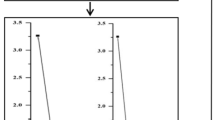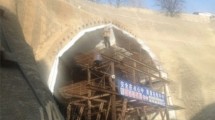Abstract
In underwater drilling and blasting engineering, the blasting vibration signal is mixed with a mass of noises due to the complexity of monitoring environment, the error of monitoring sensors and the reflection of propagation medium. In order to accurately obtain the characteristics of vibration signal, a novel denoising model is established. The complete ensemble empirical mode decomposition with adaptive noise is used to decompose the original signal, and the objective function of the filtering algorithm is used to obtain the optimal denoising signal. The results indicate that the model can not only successfully remove the high-frequency noise but also has no effect on the low-frequency signal components, which verifies the reliability and validity of the denoising model.







Similar content being viewed by others
Abbreviations
- IMF:
-
Intrinsic mode function
- x(t):
-
Original signal
- ε 0 :
-
Noise coefficient
- r(t):
-
Residual component
- n j(t):
-
White noises
- x m :
-
mth sample point of original signal
- \( \tilde{x}_{m} \) :
-
Mth sample point of denoised signal
- MSEf :
-
Mean square error
- u(x), v(x), f(x):
-
Smooth curves
- h :
-
Sampling interval
- SMSEf :
-
Mean square error of smoothness
- F :
-
Objective function
- μ :
-
Weight coefficient
- ξ :
-
Signal-to-noise ratio
- ε :
-
Mean absolute error
References
Monjezi, M.; Bahrami, A.; Yazdian, A.: Simultaneous prediction of fragmentation and flyrock in blasting operation using artificial neural networks. Int. J. Rock Mech. Min. 47(3), 476–480 (2009)
Ghoshal, R.; Mitra, N.: Underwater explosion induced shock loading of structures: influence of water depth, salinity and temperature. Ocean Eng. 126(1), 22–28 (2016)
Peng, Y.X.; Wu, L.; Chen, C.H.; Zhu, B.B.; Jia, Q.J.: Study on the robust regression of the prediction of vibration velocity in underwater drilling and blasting. Arab. J. Sci. Eng. 43, 5541–5549 (2018)
Fei, H.L.; Liu, M.; Qu, G.J.; Gao, Y.: A method for blasting vibration signal denoising based on ensemble empirical mode decomposition-wavelet threshold. Explosion Shock Waves 38(1), 112–118 (2018)
Liang, M.D.; Wu, Z.; Xia, L.M.: Application of dual shift invariant wavelet transform in blasting vibration signal denoising: IEEE 3rd International Conference on Advanced Computing and Communication Systems. (2016). https://doi.org/10.1109/ICACCS.2016.7586357
Faria, M.L.L.D.; Cugnasca, C.E.; Amazonas, J.R.A.: Insights into IoT data and an innovative dwt-based technique to denoise sensor signals. IEEE Sensors J (2017). https://doi.org/10.1109/JSEN.2017.2767383
Banjade, T.P.; Yu, S.; Ma, J.: Earthquake accelerogram denoising by wavelet-based variational mode decomposition. J. Seismol. 23, 649–663 (2019)
Yang, D.; Ren, W.X.; Xiao, X.: Structure dynamic signal denoise using multi-scale emd. Adv. Mater. Res. 168–170, 611–2614 (2010)
Rakshit, M.; Das, S.: An efficient ECG denoising methodology using empirical mode decomposition and adaptive switching mean filter. Biomed. Signal Process. Control 40, 140–148 (2018)
Wang, Z.L.; Chen, G.H.; Huang, Y.P.: Optimal white noise coefficient in EEMD corrected zero drift signal of blasting acceleration. Explosion Shock Waves 39(8), 084201 (2019)
Zhang, L.; Yan, J.L.; Li, D.T.: Application of wavelet threshold denoising method in signal preprocessing for blast vibration: IEEE 3rd International Congress on Image and Signal Processing, pp. 4028–4031 (2010)
Xie, Q.M.; Zhang, H.Z.; Gao, Y.; Cao, H.A.; Guo, S.Q.; Zhong, M.S.; Liu, H.Q.: Research on blasting vibration signal denoising based on lifting scheme. Appl. Mech. Mater. 713–715, 647–650 (2015)
Xia, L.M.; Zheng, W.; Liang, M.D.: Application of a comprehensive one dimensional wavelet threshold denoising algorithm in blasting signal. Inf. Technol. Intell. Transp. Syst. (2017). https://doi.org/10.1007/978-3-319-38771-0_51
Zhao, M.S.; Liang, K.S.; Luo, Y.F.; Xu, Y.P.: Application of EEMD in blasting vibration signal denoising. Blasting 28(2), 17–20 (2011)
Yuan, H.P.; Liu, X.L.; Liu, Y.; Bian, H.B.; Chen, W.; Wang, Y.X.: Analysis of acoustic wave frequency spectrum characters of rock mass under blasting damage based on the HHT method. Adv. Civ. Eng. (2018). https://doi.org/10.1155/2018/9207476
Chen, Y.; Gan, D.; Liu, T.; Yuan, J.; Zhang, Y.; Jin, Z.: Random noise attenuation by a selective hybrid approach using empirical mode decomposition. J. Geophys. Eng. 12, 12–22 (2015)
Torres, M.E.; Colominas, M.A.; Gasto’n, S.: A complete ensemble empirical mode decomposition with adaptive noise: Proceedings of the IEEE International Conference on Acoustics, Speech, and Signal Processing. (2011). https://doi.org/10.1109/ICASSP.2011.5947265
Colominas, M.A.; Schlotthauer, G.; Torres, M.E.: Improved complete ensemble EMD: a suitable tool for biomedical signal processing. Biomed. Signal Process. Control 14(1), 19–29 (2014)
Huang, N.E.; Shen, Z.; Long, S.R.; Wu, M.C.; Shih, H.H.; Zheng, Q.: The empirical mode decomposition and the Hilbert spectrum for nonlinear and non-stationary time series analysis. Proceed. Royal Soc. Lond. 454(3), 903–995 (1998)
Li, Q.; Xu, W.L.; Zhang, D.; Li, N.; Feng, D.D.: An improved method to eliminate modal aliasing and false component in blast vibration signals. J. Vibrat. Shock 38(17), 197–204 (2019)
Wu, Z.H.; Huang, N.E.: Ensemble empirical mode decomposition: a noise assisted data analysis method. Adv. Adapt. Data Anal. 1(1), 1–41 (2009)
Zheng, Y.; Yue, J.; Sun, X.F.; Chen, J.: Studies of filtering effect on internal solitary wave flow field data in the south china sea using EMD. Adv. Mater. Res. 518–523, 1422–1425 (2012)
Heidelberg, S.B.: Nyquist Sampling Theorem. Encyclopedia of Neuroscience (2011)
Peng, Y.X.; Su, Y.; Wu, L.; Chen, C.H.: Study on the attenuation characteristics of seismic wave energy induced by underwater drilling and blasting. Shock Vib. (2019). https://doi.org/10.1155/2019/4367698
Si, Y.Q.; Guo, R.H.; Li, M.R.: Application of optimal noise reduction smooth model based on EMD and EEMD in seismic waves. CT Theory Appl. 29(1), 11–21 (2020)
Li, T.; Wen, P.; Jayamaha, S.: Anaesthetic EEG signal denoise using improved nonlocal mean methods. Australas. Phys. Eng. Sci. Med. 37(2), 431–437 (2014)
Zhong, G.S.; Deng, Y.X.; Ao, L.P.: Study and application of translation invariant wavelet de-noising for blasting seismic signals: IEEE 2011 International Conference on Multimedia Technology. (2011). https://doi.org/10.1109/ICMT.2011.6002967
Zhang, L.; Sun, X.J.; Zhan, Q.B.: Research of filtering method for blasting vibration signals based on CEEMD and correlation function property. Water Resour. Hydropower Eng. 48(6), 37–42 (2017)
Zhang, X.L.; Jia, R.S.; Lu, X.M.; Peng, Y.J.; Zhao, W.D.: Identification of blasting vibration and coal-rock fracturing microseismic signals. Appl. Geophys. 15(2), 280–289 (2018)
Acknowledgement
This work was supported by the National Natural Science Foundation of China (Grant No. 41672260, 51704109), Natural Science Foundation of Hunan (Grant No. 2020JJ5163; 2020JJ4300) and Science Foundation of Hunan University of Science and Technology (Grant No. E51884).
Author information
Authors and Affiliations
Corresponding author
Rights and permissions
About this article
Cite this article
Peng, Y., Liu, Y., Zhang, C. et al. A Novel Denoising Model of Underwater Drilling and Blasting Vibration Signal Based on CEEMDAN. Arab J Sci Eng 46, 4857–4865 (2021). https://doi.org/10.1007/s13369-020-05274-z
Received:
Accepted:
Published:
Issue Date:
DOI: https://doi.org/10.1007/s13369-020-05274-z




